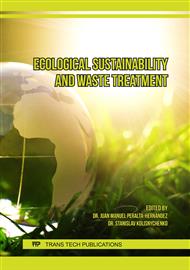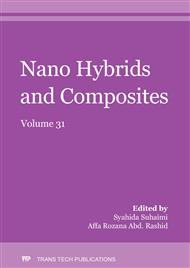[1]
P. Champagne, Chapter 9 – Biomass, in Future Energy, no. January 2008 (2008) 151–170.
Google Scholar
[2]
K. Singh, A. A. Mishra, and A. K. Yadav, Study on Beer Production From Selected Varieties of Barley, Int. Res. J. Eng. Technol. (2016) 654–659.
Google Scholar
[3]
Kirin Holdings Company Ltd, Kirin Beer University Report Global Beer Consumption by Country in 2016, Kirin Beer Univ. Rep., vol. 2016, no. Table 1 (2017) 1–6.
DOI: 10.1108/oxan-es217441
Google Scholar
[4]
K. M. Lynch, E. J. Steffen, and E. K. Arendt, Brewers' spent grain: a review with an emphasis on food and health, J. Inst. Brew., vol. 122, no. 4 (2016) 553–568.
DOI: 10.1002/jib.363
Google Scholar
[5]
S. Aliyu and M. Bala, Brewer's spent grain: A review of its potentials and applications, African J. Biotechnol., vol. 10, no. 3 (2013) 324–331.
Google Scholar
[6]
J. Yang, Q. (Sophia) He, K. Corscadden, H. Niu, J. Lin, and T. Astatkie, Advanced models for the prediction of product yield in hydrothermal liquefaction via a mixture design of biomass model components coupled with process variables, Appl. Energy, vol. 233–234, no. September 2018 (2019) 906–915.
DOI: 10.1016/j.apenergy.2018.10.035
Google Scholar
[7]
S. I. Mussatto, Brewer's spent grain: a valuable feedstock for industrial applications., J. Sci. Food Agric., vol. 94, no. 7 (2014) 1264–75.
DOI: 10.1002/jsfa.6486
Google Scholar
[8]
B. Zhang, H. J. Huang, and S. Ramaswamy, Reaction kinetics of the hydrothermal treatment of lignin, Appl. Biochem. Biotechnol., vol. 147, no. 1–3 (2008) 119–131.
DOI: 10.1007/s12010-007-8070-6
Google Scholar
[9]
S. Brand and J. Kim, Liquefaction of major lignocellulosic biomass constituents in supercritical ethanol, Energy, vol. 80 (2015) 64–74.
DOI: 10.1016/j.energy.2014.11.043
Google Scholar
[10]
L. Nazari, Z. Yuan, S. Souzanchi, M. B. Ray, and C. (Charles) Xu, Hydrothermal liquefaction of woody biomass in hot-compressed water: Catalyst screening and comprehensive characterization of bio-crude oils, Fuel, vol. 162 (2015) 74–83.
DOI: 10.1016/j.fuel.2015.08.055
Google Scholar
[11]
X. . W. Zhao L.; Liu, D., Effect of several factors on peracetic acid pretreatment of sugarcane bagasse for enzymatic hydrolysis, J. Chem. Technol. Biotechnol., vol. 82, no. August 2007 (2007) 1115–1121.
DOI: 10.1002/jctb.1775
Google Scholar
[12]
J. Akhtar and N. A. S. Amin, A review on process conditions for optimum bio-oil yield in hydrothermal liquefaction of biomass, Renew. Sustain. Energy Rev., vol. 15, no. 3 (2011) 1615–1624.
DOI: 10.1016/j.rser.2010.11.054
Google Scholar
[13]
H. A. Baloch et al., Recent advances in production and upgrading of bio-oil from biomass: A critical overview, J. Environ. Chem. Eng., vol. 6, no. 4 (2018) 5101–5118.
Google Scholar
[14]
J. Poerschmann, B. Weiner, H. Wedwitschka, I. Baskyr, R. Koehler, and F. Kopinke, Bioresource Technology Characterization of biocoals and dissolved organic matter phases obtained upon hydrothermal carbonization of brewer ' s spent grain, Bioresour. Technol., vol. 164 (2014) 162–169.
DOI: 10.1016/j.biortech.2014.04.052
Google Scholar
[15]
S. I. Mussatto and I. C. Roberto, Acid hydrolysis and fermentation of brewer's spent grain to produce xylitol,, J. Sci. Food Agric., vol. 85, no. December 2004 (2005) 2453–2460.
DOI: 10.1002/jsfa.2276
Google Scholar
[16]
A. Fărcaş et al., Brewers ' spent grain – A new potential ingredient for functional foods, J. Agroaliment. Process. Technol., vol. 20, no. 2 (2014) 137–141.
Google Scholar
[17]
E. I. El‐Shafey, M. L. F. Gameiro, P. F. M. Correia, and J. M. R. de Carvalho, Dewatering of Brewer's Spent Grain Using a Membrane Filter Press: A Pilot Plant Study, Sep. Sci. Technol., vol. 39, no. 14 (2004) 3237–3261.
DOI: 10.1081/ss-200028775
Google Scholar
[18]
A. Weger, S. Binder, M. Franke, and A. Hornung, Solid Biofuel Production by Mechanical Pre-Treatment of Brewers ' Spent Grain, vol. 37 (2014) 661–666.
Google Scholar
[19]
M. Fan, D. Dai, and B. Huang, Fourier Transform Infrared Spectroscopy for Natural Fibres, Fourier Transform - Mater. Anal. (2012).
DOI: 10.5772/35482
Google Scholar
[20]
S. Nanda, P. Mohanty, K. K. Pant, S. Naik, J. A. Kozinski, and A. K. Dalai, Characterization of North American Lignocellulosic Biomass and Biochars in Terms of their Candidacy for Alternate Renewable Fuels, Bioenergy Res., vol. 6, no. 2 (2013) 663–677.
DOI: 10.1007/s12155-012-9281-4
Google Scholar
[21]
D. L. Sills and J. M. Gossett, Using FTIR to Predict Saccharification From Enzymatic Hydrolysis of Alkali-Pretreated Biomasses, vol. 109, no. 2 (2012) 353–362.
DOI: 10.1002/bit.23314
Google Scholar



